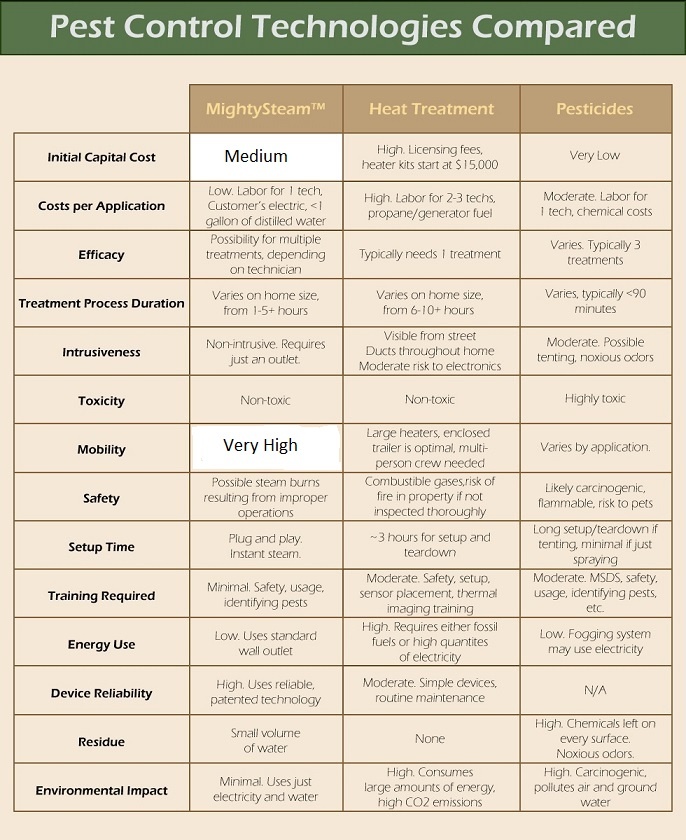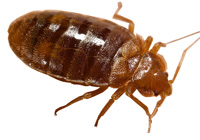Pest Control
Pest control has evolved past spraying dangerous chemicals on pests. Green, sustainable and organic pest control is the future of the industry. Chemicals leave harsh residues that can be toxic to humans and their pets. Not only are some pesticides toxic, but many chemicals in the pest control industry are also suspected of being carcinogenic. New technologies such as superheated steam, dry heat, and CO2 snow show that pest control is possible without the use of harsh chemicals. As the efficacy of each treatment varies, an appropriate strategy must be used for effective pest control. In many cases, a combination of a MightySteam®, CO2 snow, or dry heat treatment followed by a treatment of all natural, food grade diatomaceous earth and follow-up visits may effectively control a bed bug outbreak. Each situation is unique and should be evaluated by a trained pest management professional.
TheSaniZap® Products get rid of dust and dust mites? This is aspecialty of the SaniZap-600-4-240. Dust builds up throughout your homes, offices, factories warehouses. The dust may contain substances that trigger asthma symptoms, such as wheezing or coughing, or another allergic reaction, such as the rash of atopic dermatitis or stuffy nose of allergic rhinitis. These substances are called allergens. Dust mites are another example of an allergen. Source: Controlling Dust, Dust Mites, and Other Allergens in Your Home | CS Mott Children’s Hospital | Michigan Medicine. Contact Bayzi for discussions of how powerful the SaniZap® product is for cleaning dust with MightySteam®. Testimonials.
Contact us to see what data we have on Bed-Bug removal with MightySteam® from SaniZap®.

Bed Bugs
Bed Bugs die when exposed to 122°F (50°C) heat for around an hour. MightySteam’s 572°F (300°C) low-velocity steam can kill bed bugs without blowing them, or their eggs, from their present harborages. Bayzi’s suggested treatment regiment for bed bugs is relatively easy. Vacuuming followed by a MightySteam® walkthrough, treating floors, along baseboards, mattresses, and any other known bed bug harborages. While MightySteam’s temperature can easily kill bed bugs near the surface of a mattress, proper techniques can be used to penertate more. As second process step can also be used. For example one coulduse a mattress encasement after treatment to ensure the entirety of bed bugs and their eggs are eliminated. After the initial treatment, a proper application of diatomaceous earth is feasible. Diatomaceous earth is an inexpensive, 100% organic and safe powder that kills bed bugs and most crawling pests shortly after they crawl through it. After the initial visit, schedule a follow-up visit to re-inspect the property, ensuring that there are no surviving bed bugs.
Whenever a canopy of steam can be created it will help penetrate more.
Dust Mites
Dust mites can only withstand 122°F (50°C) of dry heat for 20 minutes, or 140°F (60°C) of moist heat for the same 20 minutes. With optimal operating conditions, MightySteam® is capable of killing nearly all common allergen causing mites with a residence time of approximately .1 second. Dust mites cause allergies but are often overlooked because they don’t feed on humans, but rather their dead skin cells. For this reason, many people tolerate their presence. Mites cannot withstand high temperatures, so the treatment strategy for mites using the MightySteam® is relatively simple. Using the SaniZap® on the mattress, boxspring, furniture, and carpets will eliminate the majority of dust mites, with an immediately noticeable effect. Preventing their return is more of an issue because warm, humid environments with plenty of dander, dust and dead skin are their favorite places. In addition to treating a property with MightySteam®, proper strategy to minimize a mite population may also entail suggesting a dehumidifier for use during the winter and also frequent washing of bedding materials in or water warmer than 130°F (54°C.)

Jumbo Fleas need to be exposed to 113°F (45°C) heat for 10 minutes, but with the MightySteam™ fleas can be killed as fast as .1 second. Fleas present a greater challenge for superheated steam because most fleas reside on a living host, such as a dog, cat or human. Because you don’t want to use superheated steam on your pets or other humans (NEVER use the MightySteam® on a living creature you do not wish to harm). The focus of MightySteam® should be on cleaning the residence of errant flea eggs or fleas that may be hiding in the carpet or furniture. After treatment, ensure that all pets are groomed and treated with a flea medicine or shampoo.
Weeds are a nuisance and the MightySteam’s 1112°F (600°C) steam is capable of killing weeds, and other vegetation, with minimal exposure. Vegetation control with the MightySteam® and SaniZap® units simply entails a point and steam strategy. Any vegetation exposed to superheated steam for a short period of time will die. When operating the MightySteam use care to not point it at plants you do not wish to kill, because it is indiscriminate in which vegetation it kills.
- (Jan 2002). Children Are at Greater Risks from Pesticide Exposure. U.S. Environmental Protection Agency. https://www.epa.gov/pesticides/factsheets/kidpesticide.htm
- (Sept 23, 2011) . Acute Illnesses Associated With Insecticides Used to Control Bed Bugs — Seven States, 2003— 2010. Morbidity and Mortality Weekly Report, Centers for Disease Control and Prevention. doi:60(37);1269-1274
- (Jan 2002). Children Are at Greater Risks from Pesticide Exposure. U.S. Environmental Protection Agency. https://www.epa.gov/pesticides/factsheets/kidpesticide.htm, https://www.annalsofepidemiology.org/article/S1047-2797(09)00327-5/abstract
- “Pesticides.” The Gale Encyclopedia of Science. Ed. K. Lee Lerner and Brenda Wilmoth Lerner. 4th ed. Detroit: Gale, 2008. Gale Student Resources In Context. Web. 6 July 2012. https://www.cdc.gov/mmwr/preview/mmwrhtml/mm6037a1.htm?s_cid=mm6037a1_w, https://blisstree.com/live/pesticides-harm-more-than-just-bed-bugs-296/, https://www.npr.org/2011/01/19/133057071/bed-bug-genome-reveals-pesticide-resistance , https://archive.blisstree.com/feel/itchy-runny-nose-may-be-the-pesticides/ , https://www.panna.org/children
Steam must be applied directly to bed bugs, insects and their eggs to be effective (use the special diffuser nozzle). Steam has no residual effect on bed bugs or other insects. Steam is only effective when it comes in contact with a living bed bug, insect or their eggs for the appropriate residency time. Steam can be effective in reducing bacteria counts when exposed to high enough temperatures and residency times. Bayzi offers no expressed or implied warranties as to the efficacy of steam in reducing or eliminating bacteria, microbes or pathogens.
- Pesticides have been shown to cause neurological and respiratory symptoms in humans.
- Children face greater risks from pesticide exposure, including reproductive disorders, birth defects, immune suppression, dizziness, nausea, and other problems.
- It appears that around 500,000 metric tons of pesticides are used in the United States every year.
- (Sept 23, 2011) . Acute Illnesses Associated With Insecticides Used to Control Bed Bugs — Seven States, 2003— 2010. Morbidity and Mortality Weekly Report, Centers for Disease Control and Prevention. doi:60(37);1269-1274(Jan 2002). Children Are at Greater Risks from Pesticide Exposure. U.S. Environmental Protection Agency. http://www.epa.gov/pesticides/factsheets/kidpesticide.htm
http://www.annalsofepidemiology.org/article/S1047-2797(09)00327-5/abstract“Pesticides.” The Gale Encyclopedia of Science. Ed. K. Lee Lerner and Brenda Wilmoth Lerner. 4th ed. Detroit: Gale, 2008. Gale Student Resources In Context. Web. 6 July 2012.







